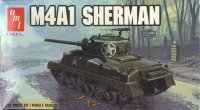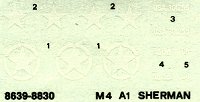
M4A1 Sherman
ESCI Kit 8028; Aurora/ESCI # 6205; ESCI/Revell # H2324; ESCI/Ertl # 8308; AMT/Ertl # 8639; Humbrol #HK72203

Never has a model generated such controversy and differing opinions, more than this old kit has over the years. Recently re-released by Italeri, this has long been one of ESCI's most popular kits. It is a highly detailed model, with some interior detail, and open hatches. The tools are molded separate, the hull machinegun is positionable, there is a complete engine, and a commander figure is even included. Early versions of the kit include the single piece vinyl tracks, which are very poor, but the later releases, including the new Italeri versions, include the hard plastic, link-and-length variety, which are quite good. This is pretty much all that one could ask for in a kit.
Except for the fact that this vehicle likely never existed. This error was brought to my attention several years ago, and I had earlier written an article describing the problem. I've retired that original article, but you can still view it here. To summarize: according to all of my references, the late style, 47 degree, large hatch, wet-stowage hull, was never paired with a 75mm gun turret. The wet-stowage hulls made their appearance with the 76mm gun turrets.
The key feature here is wet-stowage. Early Shermans had their ammunition stowed in storage bins in the hull side sponsons. This was called dry-stowage, and due to the vulnerability of ammunition explosions from hits to the storage racks, applique armor was welded onto the outside of the hull over the stowage areas. In late M4A1's, this additional armor was actually incorporated in the main hull casting at the factory, and can be seen as distinct bulges in the hull sides. Wet-stowage made its appearance around the time of the 76mm gun turrets. In these vehicles, the ammunition was moved to storage racks in the floor, and flooded with a mixture of water, anti-freeze, and flame-retardant, which would reduce the likelihood of an ammunition explosion in the event of a fire inside the tank. The ESCI kit has a wet-stowage hull, not dry-stowage.
The rumors I have seen on the internet state that there were a small number of these tanks converted to this configuration for use as DD (Duplex Drive) tanks for the US invasion forces at Normandy. Many people have sent to me photographs, or directed me to books and/or websites with photographs, which supposedly show this particular vehicle, but in all those cases, the vehicles depicted are dry-stowage hulls, not wet.
How can this model be converted to accurately represent a more common Sherman variety? I can think of three ways:
An additional area of disagreement over this kit is its scale. There are still people who insist that this kit is 1/76th scale, but all of my sources show it to be pretty accurate for 1/72nd. The only measurement discrepancy I have found is that the length of the hull is about 2mm too short, which places the length of the kit to about 1/73-1/74. Everything else is almost perfect for 1/72nd, including the wheels.

The decals in this version of the kit by AMT/Ertl, are very thin. Although the scan is poor, there are several stars, serial numbers, and a couple of slogans. The decal options vary depending on which company released the kit.
| Back to ESCI Kit List | Back to Home Page |
| Back to The Sherman Story |